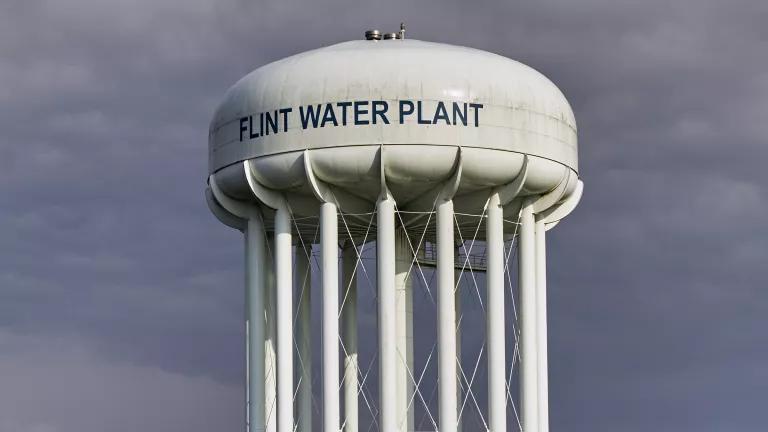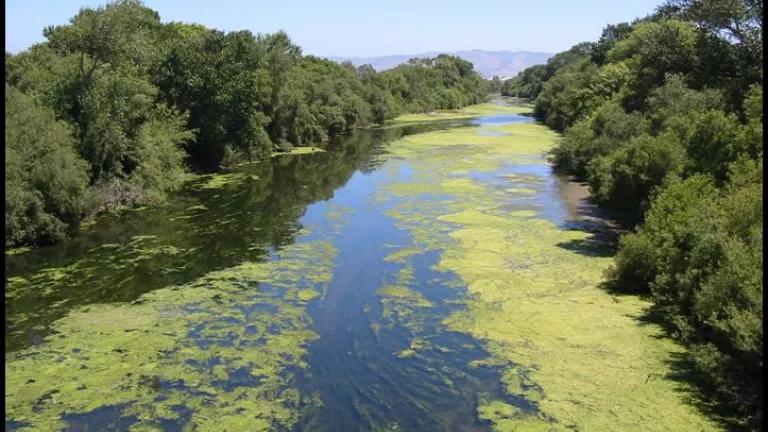Biden Proposes Big Investments in Water: It’s About Time
Biden's infrastructure plan would replace millions of lead pipes and invest billions to protect our tap water and water sources. It would be a game-changer—protecting health, investing in equity, and creating millions of living wage jobs.

A water tower at the Flint Water Plant
Carol M. Highsmith Archive/Library of Congress
Today President Biden proposed a welcome proposal that includes $111 billion investment in water infrastructure. It would fund strong measures to protect millions of Americans from water contaminated by lead, other toxic chemicals, and pathogens. The package would create a bevy of new living wage jobs while protecting our health. Congress should take prompt action to move these priorities forward.
Investing in water infrastructure is investing in equity. As we have learned from our studies and from communities we’ve worked in, including Flint, Newark, Pittsburgh and other cities, those who are left behind by disinvestment in water infrastructure are disproportionately low-income communities of color. Disadvantaged rural and Tribal communities also are at serious risk. Families in these communities often must live every day with seriously contaminated water or no water at all, have lead service lines, and sometimes have raw sewage flowing in their streets or lack sanitation altogether. In many of these communities, democracy itself has been seriously undermined. In Flint, for example, state-appointed officials made the fateful ill-considered decisions that led to serious contamination, with residents and their elected local representatives effectively disenfranchised. Meanwhile, water rates continue to rise, making water unaffordable for many low-income families around the country and putting them at risk of losing water service altogether. Similar tales can be told in many other communities. Only with reforms of how our water systems are run and with major federal investments, can the nation’s water woes be remedied.
It’s also important to keep in mind that investing in water infrastructure is a big job creator. For example, a recent study by the Metropolitan Planning Council found that replacing all of Illinois’ lead service lines alone could create up to 224,500 jobs and $23 billion in additional economic activity. Amplify that to a national investment, and the number of new good-paying jobs will be enormous.
Among the most significant water proposals in the Biden plan is to dig up and replace all 6 to 10 million lead service lines, which are found in every state, D.C., and Puerto Rico, at a cost of $45 billion. This is crucial, since removing lead from the system is the only way to ensure that generations of kids will be safe from lead-contaminated tap water.
An additional $56 billion would be injected into programs that fund upgrades to wastewater, stormwater, and drinking water infrastructure. This increase is a big step in the right direction toward meeting the estimated $750 billion needed to bring our nation’s water systems into good repair.
After decades of dithering, it’s about time to finally get serious. China and other countries around the planet have been investing in their infrastructure and leaving us in the dust. We have aging and decrepit roads, bridges, transit, wastewater, and drinking water systems. The American Society of Civil Engineers recently gave our wastewater infrastructure a D+ grade, stormwater infrastructure a D, and drinking water infrastructure an embarrassing C-. It’s a report card you’d want to hide from mom and dad.
If enacted, the Biden package would take big steps towards cleaning up tens of millions of people’s tap water contaminated by lead, PFAS (per- and polyfluoroalkyl substances), and other pollutants. In addition to the significant water infrastructure spending, the proposal would also invest in cleaning up and protecting groundwater and surface water sources to improve our health and the environment.
The Biden plan says it would target 40 percent of the benefits of climate and clean infrastructure investments to disadvantaged communities. Ensuring that water infrastructure funding is prioritized this way will be key to addressing the historical and ongoing disinvestment in these areas.
Key investments, taken from the background documents released by the White House, would address:
Water Infrastructure
- Eliminate Lead Service Lines. Consistent with the pleas from community leaders, health experts, NRDC, and others the Biden plan would eliminate 100% of lead pipes and service lines in drinking water systems to improve the health of children and particularly communities of color.
- Funding for Removing Lead Pipes in Homes, Schools, Childcares. To eliminate all lead pipes and service lines, the plan would invest $45 billion in EPA’s Drinking Water State Revolving Fund (SRF) and in Water Infrastructure Improvements for the Nation Act (WIIN) grants. The funds to be targeted at investing in reducing lead in homes and 400,000 schools and childcare facilities.
- Upgrade and Modernize Drinking Water, Wastewater, and Stormwater Systems. The plan would modernize aging water systems by scaling up existing, successful programs, including by providing $56 billion in grants and low-cost flexible loans to states, Tribes, territories, and disadvantaged communities.
- Address PFAS Contamination. The plan would provide $10 billion to monitor and remediate PFAS in drinking water and to invest in rural small water systems and household well and wastewater systems, including drainage fields. As we’ve discussed in more detail previously, PFAS contamination is a major threat to millions of Americans.
Protecting and Cleaning up Groundwater and Surface Waters
- Clean up Brownfields and Superfund Sites. The plan would invest $5 billion in cleanup and redevelopment of Brownfield and Superfund sites, and in related economic and workforce development. These sites often are the source of groundwater and surface water pollution. The goal is to turn this idle property into new hubs of economic growth and job creation.
- Plugging Orphan Oil and Gas Wells and Cleaning Up Abandoned Mines. Hundreds of thousands of orphan former oil and gas wells and abandoned mines pose serious safety hazards, while causing air, water, and other environmental damage. Many of these old wells and mines are in rural communities that have suffered from years of disinvestment. The plan would make an immediate up-front investment of $16 billion to put hundreds of thousands to work in union jobs plugging oil and gas wells and restoring and reclaiming abandoned coal, hard rock, and uranium mines. In addition to creating living wage jobs in hard-hit communities, this would reduce methane air emissions, and address the brine that leaks from these wells and can contaminate water sources.
- Mobilize the Next Generation of Conservation and Resilience Workers. The plan would make a $10 billion investment to put a new, diverse generation of Americans to work with living wage jobs conserving public lands and waters, bolstering community resilience, and advancing environmental justice through a new Civilian Climate Corps. Restoration of watersheds and wetlands can significantly improve water quality of groundwater and surface water.
- Address Rural Water and Other Infrastructure Issues. The plan would invest $5 billion for a new Rural Partnership Program to help rural regions, including Tribal Nations, invest in water and other infrastructure and take other measures to build on their assets and realize their vision for inclusive community and economic development.
Nature-Based Infrastructure, Resilience, and Water Efficiency and Recycling
- Protecting and Restoring Nature-Based Infrastructure to Protect Water Resources. The plan would protect and restore nature-based infrastructure including lands, forests, wetlands, watersheds, and coastal and ocean resources. The proposal would invest in protection from extreme wildfires, coastal resilience to sea-level rise and hurricanes, support agricultural resources management and climate-smart technologies, and protect and restore major land and water resources like Florida’s Everglades and the Great Lakes.
- Improving Resilience to Drought and Climate Change in the Western U.S.: The plan would improve the West’s resilience to drought and climate change by investing in water efficiency, water recycling, Tribal water settlements, among other projects.




